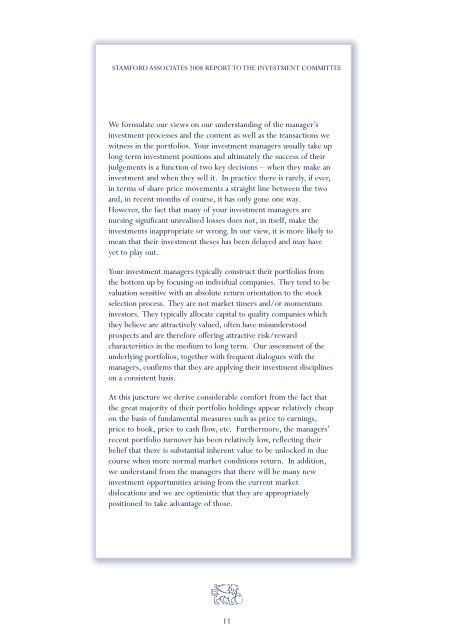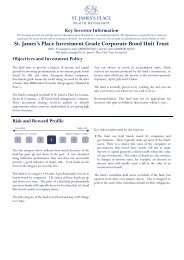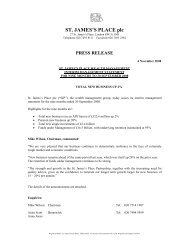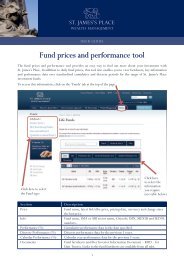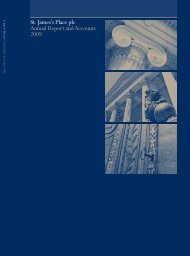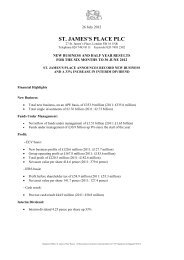Report of the Investment Committee 2008 - St James's Place
Report of the Investment Committee 2008 - St James's Place
Report of the Investment Committee 2008 - St James's Place
Create successful ePaper yourself
Turn your PDF publications into a flip-book with our unique Google optimized e-Paper software.
STAMFORD ASSOCIATES <strong>2008</strong> REPORT TO THE INVESTMENT COMMITTEEWe formulate our views on our understanding <strong>of</strong> <strong>the</strong> manager’sinvestment processes and <strong>the</strong> content as well as <strong>the</strong> transactions wewitness in <strong>the</strong> portfolios. Your investment managers usually take uplong term investment positions and ultimately <strong>the</strong> success <strong>of</strong> <strong>the</strong>irjudgements is a function <strong>of</strong> two key decisions – when <strong>the</strong>y make aninvestment and when <strong>the</strong>y sell it. In practice <strong>the</strong>re is rarely, if ever,in terms <strong>of</strong> share price movements a straight line between <strong>the</strong> twoand, in recent months <strong>of</strong> course, it has only gone one way.However, <strong>the</strong> fact that many <strong>of</strong> your investment managers arenursing significant unrealised losses does not, in itself, make <strong>the</strong>investments inappropriate or wrong. In our view, it is more likely tomean that <strong>the</strong>ir investment <strong>the</strong>ses has been delayed and may haveyet to play out.Your investment managers typically construct <strong>the</strong>ir portfolios from<strong>the</strong> bottom up by focusing on individual companies. They tend to bevaluation sensitive with an absolute return orientation to <strong>the</strong> stockselection process. They are not market timers and/or momentuminvestors. They typically allocate capital to quality companies which<strong>the</strong>y believe are attractively valued, <strong>of</strong>ten have misunderstoodprospects and are <strong>the</strong>refore <strong>of</strong>fering attractive risk/rewardcharacteristics in <strong>the</strong> medium to long term. Our assessment <strong>of</strong> <strong>the</strong>underlying portfolios, toge<strong>the</strong>r with frequent dialogues with <strong>the</strong>managers, confirms that <strong>the</strong>y are applying <strong>the</strong>ir investment disciplineson a consistent basis.At this juncture we derive considerable comfort from <strong>the</strong> fact that<strong>the</strong> great majority <strong>of</strong> <strong>the</strong>ir portfolio holdings appear relatively cheapon <strong>the</strong> basis <strong>of</strong> fundamental measures such as price to earnings,price to book, price to cash flow, etc. Fur<strong>the</strong>rmore, <strong>the</strong> managers’recent portfolio turnover has been relatively low, reflecting <strong>the</strong>irbelief that <strong>the</strong>re is substantial inherent value to be unlocked in duecourse when more normal market conditions return. In addition,we understand from <strong>the</strong> managers that <strong>the</strong>re will be many newinvestment opportunities arising from <strong>the</strong> current marketdislocations and we are optimistic that <strong>the</strong>y are appropriatelypositioned to take advantage <strong>of</strong> those.11


